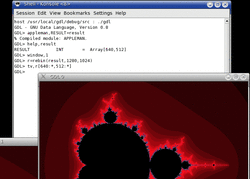 GDL rendering the Mandelbrot set | |
| Developer(s) | Marc Schellens |
|---|---|
| Initial release | 2004 |
| Stable release | 0.9.9-rc2 / March 5, 2020 |
| Repository | |
| Written in | C++ (wxWidgets) |
| Platform | Linux, Mac OS X, Solaris, POSIX, Windows |
| Type | Technical computing |
| License | GNU General Public License |
| Website | github |
The GNU Data Language (GDL) is a free alternative to IDL (Interactive Data Language).[1][2][3] Together with its library routines, GDL is developed to serve as a tool for data analysis and visualization in such disciplines as astronomy,[4] geosciences, and medical imaging. GDL is licensed under the GPL. Other open-source numerical data analysis tools similar to GDL include GNU Octave, NCAR Command Language (NCL), Perl Data Language (PDL), R, Scilab, SciPy, and Yorick.
GDL as a language is dynamically-typed, vectorized, and has object-oriented programming capabilities. GDL library routines handle numerical calculations (e.g. FFT), data visualisation, signal/image processing, interaction with host OS, and data input/output. GDL supports several data formats, such as NetCDF, HDF (v4 & v5), GRIB, PNG, TIFF, and DICOM. Graphical output is handled by X11, PostScript, SVG, or z-buffer terminals, the last one allowing output graphics (plots) to be saved in raster graphics formats. GDL features integrated debugging facilities, such as breakpoints. GDL has a Python bridge (Python code can be called from GDL; GDL can be compiled as a Python module). GDL uses Eigen (C++ library) numerical library (similar to Intel MKL) to offer high computing performance on multi-core processors.
Packaged versions of GDL are available for several Linux and BSD flavours as well as Mac OS X. The source code compiles on Microsoft Windows and other UNIX systems, including Solaris.
GDL is not an official GNU package.
See also
References
- ^ Martellaro, John (2006-12-12). "A Free Alternative to IDL". The Mac Observer. Archived from the original on 2011-07-31. Retrieved 2011-07-31.
- ^ Khanna (2006-12-13). "GDL .. a free IDL". MacResearch. Archived from the original on 2011-07-31. Retrieved 2011-07-31.
- ^ Coulais, Alain; et al. (2010). "Status of GDL - GNU Data Language". Astronomical Society of the Pacific Conference Series. Astronomical Data Analysis Software and Systems XIX. 434. Astronomical Society of the Pacific. p. 187. arXiv:1101.0679. Bibcode:2010ASPC..434..187C. ISBN 978-1-58381-748-3.
- ^ Mina Koleva; Philippe Prugniel; Antoine Bouchard; Yue Wu (2009). "ULySS: A Full Spectrum Fitting Package". Astronomy & Astrophysics. 501 (3): 1269–1279. arXiv:0903.2979. Bibcode:2009A&A...501.1269K. doi:10.1051/0004-6361/200811467. S2CID 14595053.; B.F. Roukema (2010). "On the suspected timing error in WMAP map-making". Astronomy & Astrophysics. 518: A34. arXiv:1004.4506. Bibcode:2010A&A...518A..34R. doi:10.1051/0004-6361/201014865.
External links
- Official website
- Running the GNU Data Language on coLinux
- GNU Data Language at Open Hub
- Linux packages: ArchLinux, Debian, Fedora, Gentoo, Ubuntu,
- BSD/OSX ports: Fink, FreeBSD, Macports